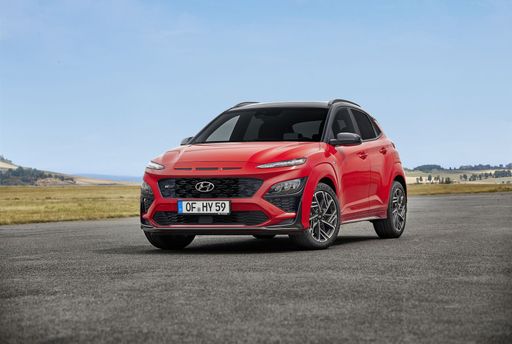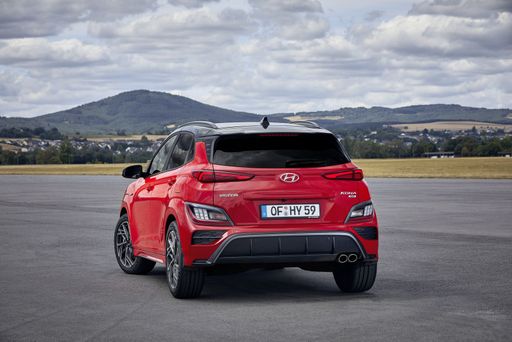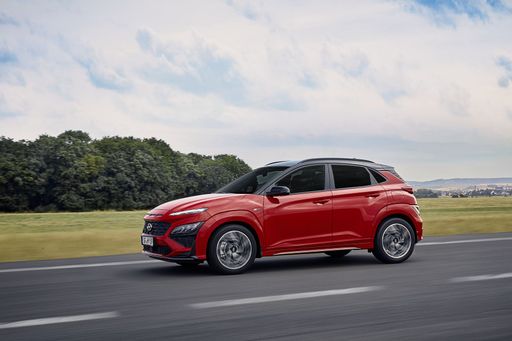Hyundai Kona vs Renault R4 – Which one offers the better deal?
Everyday use, family trips or long-distance drives – here’s where the differences show.
Discover whether Hyundai Kona or Renault R4 fits your lifestyle better.
Here’s where it gets real: The technical differences in detail
Costs and Efficiency: Price and efficiency are often the first things buyers look at. Here it becomes clear which model has the long-term edge – whether at the pump, the plug, or in purchase price.
Hyundai Kona has a hardly any advantage in terms of price – it starts at 23100 £, while the Renault R4 costs 25200 £. That’s a price difference of around 2143 £.
In terms of energy consumption, the advantage goes to the Renault R4: with 14.20 kWh per 100 km, it’s barely noticeable more efficient than the Hyundai Kona with 14.60 kWh. That’s a difference of about 0.40 kWh.
As for range, the Hyundai Kona performs clearly better – achieving up to 514 km, about 105 km more than the Renault R4.
Engine and Performance: Under the bonnet, it becomes clear which model is tuned for sportiness and which one takes the lead when you hit the accelerator.
When it comes to engine power, the Hyundai Kona has a noticeably edge – offering 218 HP compared to 150 HP. That’s roughly 68 HP more horsepower.
In acceleration from 0 to 100 km/h, the Hyundai Kona is barely noticeable quicker – completing the sprint in 7.80 s, while the Renault R4 takes 8.20 s. That’s about 0.40 s faster.
In terms of top speed, the Hyundai Kona performs noticeably better – reaching 210 km/h, while the Renault R4 tops out at 150 km/h. The difference is around 60 km/h.
There’s also a difference in torque: the Hyundai Kona pulls barely noticeable stronger with 265 Nm compared to 245 Nm. That’s about 20 Nm difference.
Space and Everyday Use: Whether family car or daily driver – which one offers more room, flexibility and comfort?
Both vehicles offer seating for 5 people.
In curb weight, the Hyundai Kona is slight lighter – 1370 kg compared to 1485 kg. The difference is around 115 kg.
In terms of boot space, the Hyundai Kona offers barely noticeable more room – 466 L compared to 420 L. That’s a difference of about 46 L.
In maximum load capacity, the Renault R4 performs slight better – up to 1405 L, which is about 105 L more than the Hyundai Kona.
When it comes to payload, Hyundai Kona hardly any takes the win – 490 kg compared to 443 kg. That’s a difference of about 47 kg.
Our conclusion: The Hyundai Kona proves to be dominates this comparison and thus becomes our DriveDuel Champion!
Overall, Hyundai Kona is the better all-rounder in this comparison.
Hyundai Kona
The Hyundai Kona blends a bold design with a versatile interior, making it a standout choice in the compact SUV market. Its crisp handling and responsive steering provide an engaging driving experience, whether in the city or on the open road. The vehicle also offers a range of features designed to enhance comfort and connectivity, ensuring a pleasurable journey for both driver and passengers.
details @ hyundai.news
@ hyundai.news
 @ hyundai.news
@ hyundai.news
 @ hyundai.news
@ hyundai.news
 @ hyundai.news
@ hyundai.news
Renault R4
The Renault R4, affectionately known as the "R4," is a quintessential symbol of French automotive simplicity and practicality. This classic compact car, originally introduced in the early 1960s, won over numerous enthusiasts with its versatile design and dependable performance. Its no-frills charm and robust build made it a beloved choice for rural drivers and city dwellers alike, cementing its status as an iconic piece of automotive history.
details

|
|
|
|
|
Costs and Consumption |
|
|---|---|
|
Price
23100 - 41600 £
|
Price
25200 - 31200 £
|
|
Consumption L/100km
4.6 - 7 L
|
Consumption L/100km
-
|
|
Consumption kWh/100km
14.6 - 16.8 kWh
|
Consumption kWh/100km
14.2 - 15.1 kWh
|
|
Electric Range
377 - 514 km
|
Electric Range
308 - 409 km
|
|
Battery Capacity
1.3 - 65.4 kWh
|
Battery Capacity
40 - 52 kWh
|
|
co2
0 - 163 g/km
|
co2
0 g/km
|
|
Fuel tank capacity
38 - 47 L
|
Fuel tank capacity
-
|
Dimensions and Body |
|
|---|---|
|
Body Type
SUV
|
Body Type
SUV
|
|
Seats
5
|
Seats
5
|
|
Doors
5
|
Doors
5
|
|
Curb weight
1370 - 1773 kg
|
Curb weight
1485 - 1537 kg
|
|
Trunk capacity
466 L
|
Trunk capacity
420 L
|
|
Length
4350 - 4385 mm
|
Length
4144 mm
|
|
Width
1825 mm
|
Width
1808 mm
|
|
Height
1580 - 1585 mm
|
Height
1552 mm
|
|
Max trunk capacity
1300 L
|
Max trunk capacity
1405 L
|
|
Payload
420 - 490 kg
|
Payload
410 - 443 kg
|
Engine and Performance |
|
|---|---|
|
Engine Type
Electric, Petrol, Full Hybrid
|
Engine Type
Electric
|
|
Transmission
Automatic, Manuel
|
Transmission
Automatic
|
|
Transmission Detail
Manual Gearbox, Dual-Clutch Automatic
|
Transmission Detail
Reduction Gearbox
|
|
Drive Type
Front-Wheel Drive, All-Wheel Drive
|
Drive Type
Front-Wheel Drive
|
|
Power HP
115 - 218 HP
|
Power HP
122 - 150 HP
|
|
Acceleration 0-100km/h
7.8 - 11.9 s
|
Acceleration 0-100km/h
8.2 - 9.2 s
|
|
Max Speed
162 - 210 km/h
|
Max Speed
150 km/h
|
|
Torque
200 - 265 Nm
|
Torque
225 - 245 Nm
|
|
Number of Cylinders
3 - 4
|
Number of Cylinders
-
|
|
Power kW
85 - 160 kW
|
Power kW
90 - 110 kW
|
|
Engine capacity
998 - 1598 cm3
|
Engine capacity
-
|
General |
|
|---|---|
|
Model Year
2024 - 2025
|
Model Year
2025
|
|
CO2 Efficiency Class
A, D, C, E, F
|
CO2 Efficiency Class
A
|
|
Brand
Hyundai
|
Brand
Renault
|
Is the Hyundai Kona offered with different drivetrains?
Available configurations include Front-Wheel Drive or All-Wheel Drive.
The prices and data displayed are estimates based on German list prices and may vary by country. This information is not legally binding.
